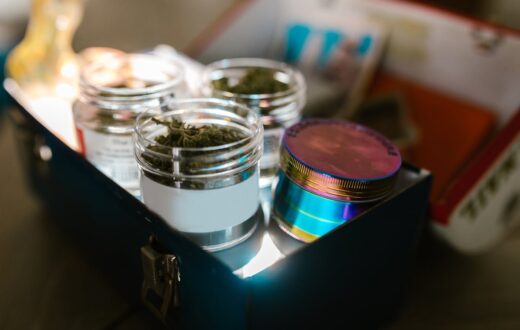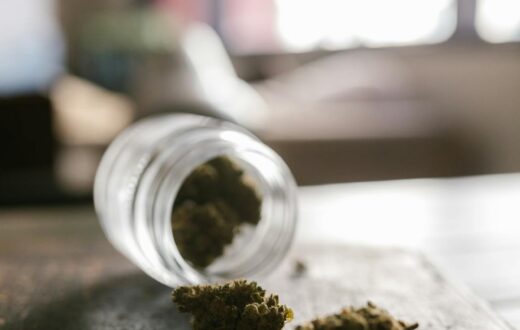Introduction to Zkittlez Strain
The Zkittlez strain has gained significant prominence among cannabis enthusiasts, thanks primarily to its delightful flavor profile and well-rounded effects. Originating from a carefully selected mix of genetic lineages, Zkittlez is a hybrid strain that blends the vibrant traits of Indica and Sativa varieties. This highly sought-after strain can be traced back to the combination of Grape Ape and Grapefruit, resulting in an aromatic experience that transports users to a fruity paradise.
The growing popularity of Zkittlez has made it a fundamental choice for both novice and seasoned growers who are seeking to understand how to grow the Zkittlez strain effectively. Its reputation for producing vibrant, resinous buds packed with flavor is supported by the strain’s ability to deliver a balanced high that can uplift and relax simultaneously. The unique sweet and fruity aroma akin to a bowl of candy contributes significantly to its appeal and cultivates a loyal following among consumers.
In terms of effects, users often report feelings of euphoria, creativity, and relaxation, which makes Zkittlez an excellent choice for social gatherings or a relaxing evening at home. The strain is also known for its medicinal properties, assisting with various ailments such as stress and anxiety. The combination of pleasant effects and the fruity taste solidifies Zkittlez as a strain worthy of cultivation. Growers interested in developing their skills will find this strain particularly rewarding due to its resilience and adaptability in different growing environments.
As we delve deeper into the intricacies of how to grow the Zkittlez strain, this guide will cover essential cultivation techniques, tips, and considerations to ensure a successful yield of these fascinating cannabis plants.
Understanding the Genetics of Zkittlez
The Zkittlez strain has garnered significant attention in the cannabis community, and much of this appeal can be attributed to its unique genetic composition. This strain traces its lineage chiefly to two parent strains: Grape Ape and Grapefruit. Grape Ape is renowned for its potent effects and sweet, fruity aroma, while Grapefruit contributes a vibrant citrus profile and uplifting characteristics. The combination of these two genetic lines culminates in a hybrid strain that showcases an exquisite blend of flavors and aromas, making it a favorite among growers and connoisseurs alike.
When cultivating Zkittlez, understanding its genetic background is pivotal. The strain leans toward an indica dominance, which is indicative of its growth patterns. Typically, cultivators can expect Zkittlez plants to exhibit bushy foliage, requiring a moderate amount of space and attention during the vegetative stage. The interplay between Grape Ape and Grapefruit not only influences the plant’s aesthetic traits but also affects its yield and flowering time. Generally, Zkittlez reaches maturity within 8 to 9 weeks after flowering begins, offering a rewarding harvest for growers who adhere to optimal cultivation practices.
Moreover, the flavor and aroma profiles of Zkittlez cannot be overstated. The sweet and fruity notes layered with hints of tartness echo back to its parent strains, showcasing a delightful taste experience for users. This complex genetic makeup results in a strain that not only satisfies the palate but also provides a balanced and potent high, promoting relaxation and euphoria. Ultimately, for those interested in how to grow the Zkittlez strain successfully, it is essential to consider these genetic factors, as they play a crucial role in the overall growth characteristics, health, and ultimate quality of the crop.
Ideal Growing Conditions for Zkittlez
To successfully cultivate the Zkittlez strain, understanding the ideal growing conditions is crucial. This strain thrives in environments that closely resemble its native conditions, which helps in maximizing growth potential and yield. Temperature plays a significant role; Zkittlez prefers a range of 70°F to 80°F (21°C to 27°C) during the day and slightly cooler temperatures at night. Maintaining this temperature range ensures optimal photosynthesis and overall plant health.
Humidity levels are another essential factor in the growth of Zkittlez. During the vegetative stage, a humidity level of 40%-60% is ideal to promote healthy growth. As the plants transition into the flowering stage, reducing humidity to around 40%-50% can help prevent mold and mildew, which are common concerns with this strain. Proper air circulation is also crucial to help maintain these humidity levels and ensure that the plants receive adequate airflow.
When it comes to light exposure, Zkittlez performs best under bright, full-spectrum lights if grown indoors. Providing 18 hours of light in the vegetative phase followed by 12 hours during flowering will encourage optimal bud development. For outdoor cultivation, ensure that Zkittlez gets ample sunlight natural sunlight exposure for the best results, ideally receiving around 6-8 hours of direct sunlight each day. The right light exposure not only supports robust growth but also contributes to the vibrant colors and fruity aromas characteristic of this strain.
Finally, soil type is another critical component of cultivating Zkittlez effectively. A rich, loamy soil mixture that drains well is recommended, often enhanced with organic matter such as compost. Nutrient-rich substrates will better support the plant’s growth and enhance its flavor profile. By carefully managing these factors, growers can ensure a successful harvest of this beloved cannabis strain, learning exactly how to grow Zkittlez strain to its fullest potential.
Nutritional Needs and Watering Schedule
The successful cultivation of the Zkittlez strain requires an understanding of its nutritional needs and a well-structured watering schedule. This strain, recognized for its vibrant flavors and impressive yields, thrives when provided with the appropriate balance of macronutrients and micronutrients throughout its growth stages. Key macronutrients include nitrogen, phosphorus, and potassium, often abbreviated as N-P-K, which are vital for various plant functions such as growth, flowering, and overall health.
Nitrogen is essential during the vegetative stage, as it promotes healthy leaf development and robust growth. As plants transition into flowering, the need for phosphorus increases; this element is crucial for root development and the overall blooming process. Potassium supports numerous functions, including water regulation and disease resistance, which further ensures the plant’s vitality. In addition to these primary nutrients, Zkittlez plants also require a range of micronutrients such as magnesium, calcium, and trace elements like zinc and iron to thrive. These micronutrients assist in vital processes, including photosynthesis and enzyme function.
Implementing a feeding schedule is paramount to meet the nutritional needs of Zkittlez plants effectively. Typically, growers should begin feeding with a nutrient mix high in nitrogen during the initial vegetative phase. As plants start flowering, transitioning to a nutrient mix higher in phosphorus and potassium is advisable. Additionally, considering a well-timed nutrient flush before harvest is essential to eliminate any residual buildup in the soil. When it comes to watering, a consistent schedule that allows the soil to dry out slightly between waterings will encourage healthy root growth. Monitoring moisture levels is critical; overwatering can lead to root rot, while underwatering can stress the plants and affect yield.
By providing Zkittlez plants with the essential nutrients and maintaining a proper watering schedule, growers can optimize their growth potential, leading to a fruitful harvest.
Germination and Seedling Stage
Growing the Zkittlez strain begins with successful germination of its seeds, a critical step that determines the health and vitality of your plants. There are various methods to germinate your Zkittlez seeds, but two of the most popular techniques are the paper towel method and direct soil planting.
For the paper towel technique, start by moistening two paper towels—ensuring they are damp but not soaking wet. Place your Zkittlez seeds between the folds of one towel, then cover with the other damp towel. Keep the seeds in a warm, dark location, such as a cupboard or drawer. Check daily to ensure the towels remain moist and watch for sprouts; this should occur within a few days. Once the seeds develop a taproot of about half an inch, gently transplant them into the soil, taking care not to damage the delicate root.
Alternatively, for direct soil planting, select a high-quality seedling mix that provides good drainage. Make a small hole in the soil about a quarter of an inch deep and place the Zkittlez seed in the hole, then cover it lightly with soil. Water the area gently, ensuring the soil is moist but not saturated. It’s crucial to keep the soil consistently damp during this phase, which encourages germination.
After germination, seedlings require ample light to thrive. If growing indoors, use a full-spectrum grow light positioned 12 to 18 inches above the seedlings, maintaining a light cycle of approximately 18 hours of light and 6 hours of darkness. Ensure that the seedlings receive adequate ventilation as well, which prevents mold and ensures strong stem growth.
As the seedlings grow stronger, consider transplanting them into larger pots when they have developed their first set of true leaves. This provides them with more space for root development and promotes vigorous growth, setting the stage for successful cultivation of the Zkittlez strain.
Vegetative and Flowering Stages
The growth of the Zkittlez strain can be divided into two critical phases: the vegetative and flowering stages. Each of these stages requires specific care and environmental adjustments to ensure optimal plant health and yield. Understanding how to grow Zkittlez strain effectively involves recognizing the transition between these stages, alongside implementing essential cultivation techniques.
During the vegetative stage, the plants prioritize leaf and stem development. This is the opportune moment for growers to train their plants using methods like Low-Stress Training (LST). LST involves gently bending and securing branches to promote lateral growth and maximize light exposure. This technique not only helps in maintaining a shorter plant height but also encourages a more substantial yield by facilitating a bushier structure. It is advisable to maintain an 18/6 light cycle during this phase to encourage robust growth.
As the plants progress towards the flowering stage, environmental changes are necessary. Transitioning to a 12/12 light cycle signals the plants to initiate flowering, which typically occurs between 6 to 10 weeks after germination, depending on the specific phenotype of the Zkittlez strain. Careful monitoring of the plants during this time is essential. Keep a close eye on the signs of maturity, such as the appearance of pistils, which indicate that the female plants are ready to flower.
Pruning is another critical practice during both stages. Removing excess foliage allows for better airflow and light penetration, promoting overall plant health. By understanding when and how to prune, along with employing LST techniques, growers can effectively manage their plants during the vegetative stage, paving the way for a successful transition into flowering. This approach also emphasizes the importance of periodic inspections to ensure that the plants are not just healthy, but also progressing towards a bountiful harvest.
Pest and Disease Management
Pest and disease management is a critical aspect of cultivating the Zkittlez strain, as its vibrant buds and enticing aroma can attract various threats. Recognizing common pests such as spider mites, aphids, and whiteflies is essential, as these insects can rapidly damage the plant’s foliage and overall health. Early detection plays a significant role in effective management; signs of infestations may include discolored leaves, webbing, or sticky secretions on the plant’s surfaces. Growers should regularly inspect their plants to catch these indicators as soon as they appear.
To maintain a healthy grow environment, implementing preventative measures can significantly reduce the likelihood of pest issues. Zkittlez plants thrive in well-ventilated spaces, as proper airflow helps deter pests. Moreover, organic treatments, such as neem oil or insecticidal soap, can be effective in managing outbreaks without harming the plant or its environment. Additionally, introducing beneficial insects like ladybugs or predatory mites can naturally curtail pest populations.
Diseases such as powdery mildew and root rot can also pose a threat to Zkittlez strains. Powdery mildew typically manifests as white fungal spots on leaves, indicating excessive humidity and poor air circulation. To prevent this, maintaining optimal humidity levels and ensuring adequate spacing between plants is crucial. On the other hand, root rot often results from overwatering and poor drainage. Growers should monitor soil moisture and adopt a watering schedule that allows the roots to breathe. Using high-quality soil that promotes drainage can help mitigate this risk.
By employing proactive strategies, cannabis cultivators can safeguard their Zkittlez plants from pests and diseases, fostering a robust and resilient grow environment. Monitoring and early intervention are key to preserving the quality and yield of this sought-after strain.
Harvesting and Curing Zkittlez Buds
Proper harvesting and curing techniques play a crucial role in the cultivation of the Zkittlez strain. Recognizing the right time to harvest is essential to ensure optimal flavor and potency. Signs indicating that Zkittlez is ready for harvest include the coloration of the trichomes and the status of the pistils. Growers should ideally look for mostly cloudy trichomes with some amber ones, indicating peak THC levels. Simultaneously, the pistils should have turned from bright white to a darker hue, typically brown or orange, indicating maturity.
Once the cannabis plants have reached their peak ripeness, the cutting techniques are of utmost importance. Using sharp and sanitized cutting tools, growers should remove the branches at the base of the stem. It is advisable to work during the cooler hours of the day to reduce the risk of stress on the plant and preserve the quality of the buds. Attention to detail during the cutting process can greatly affect the overall quality of the final product.
Following the harvest, trimming the Zkittlez buds is crucial. Trimming involves eliminating large fan leaves and excess foliage to promote even curing and enhance path airflow, which is vital in preventing mold and improving taste. After trimming, the next step is curing, which is essential for enriching the cannabis’s flavor and potency. The curing process should be executed in controlled environments, ideally in glass jars. It is recommended to fill the jars only three-quarters full, allowing room for air exchange. Opening the jars daily for the first few weeks helps to release moisture and circulate fresh air. This slow curing process is beneficial as it enhances the aromatic compounds, giving Zkittlez its characteristic sweet flavor profile that enthusiasts appreciate. By following these steps, growers can maximize their Zkittlez strain’s quality and overall appeal.
Final Thoughts and Tips for Growers
Successfully growing the Zkittlez strain requires attention to detail and a commitment to creating optimal growing conditions. This particular strain, known for its vibrant and fruity flavor profiles, thrives in a controlled environment that offers adequate light, humidity, and temperature. It is crucial for growers to monitor these elements closely to ensure a healthy and productive crop.
One essential tip for maximizing both yields and quality is to consider the use of training techniques such as low-stress training (LST) or screen of green (ScrOG). These methods not only help manage plant height but also promote better light penetration, leading to increased bud production. Additionally, implementing a regular feeding schedule tailored to the Zkittlez strain’s nutritional needs can significantly enhance growth and overall cannabinoid content.
Another point worth mentioning is the importance of pest and disease management. Regular inspection of plants can prevent potential issues from escalating. If you notice any signs of pests or diseases, taking immediate action can save your crop from significant damage. Utilizing organic pest control methods can ensure you maintain the strain’s quality while being environmentally friendly.
Moreover, as a grower, joining a community of cannabis enthusiasts can provide invaluable support and tips on how to grow Zkittlez strain successfully. Engaging with fellow growers allows for sharing experiences, troubleshooting challenges, and discovering new techniques that can lead to better harvests.
In summary, growing the Zkittlez strain is a rewarding endeavor when approached with the right knowledge and practices. By applying the aforementioned tips and staying actively involved in grower communities, you can maximize both yields and the unique qualities that this strain is known for. Embrace the journey of cultivation, and don’t hesitate to share your experiences and insights with others.














